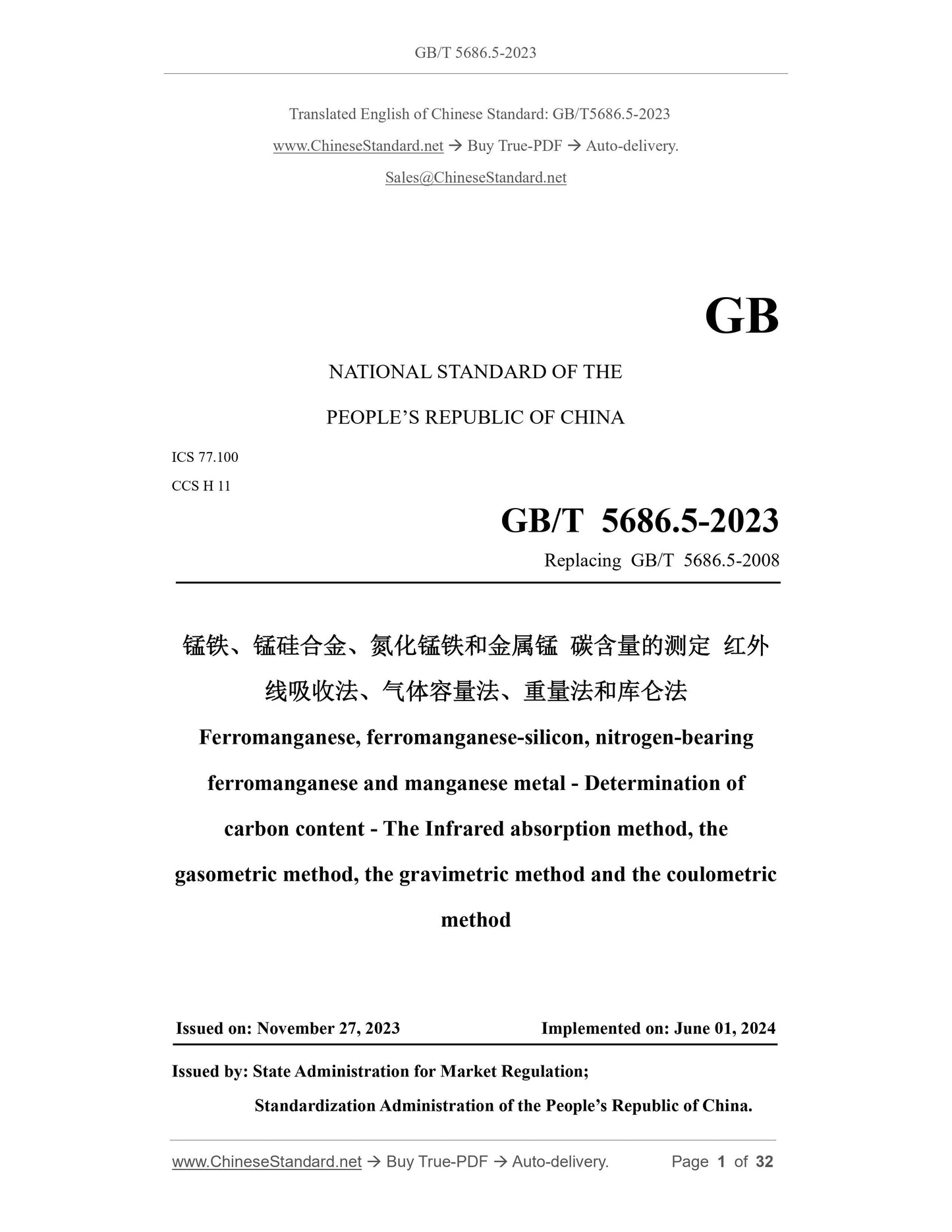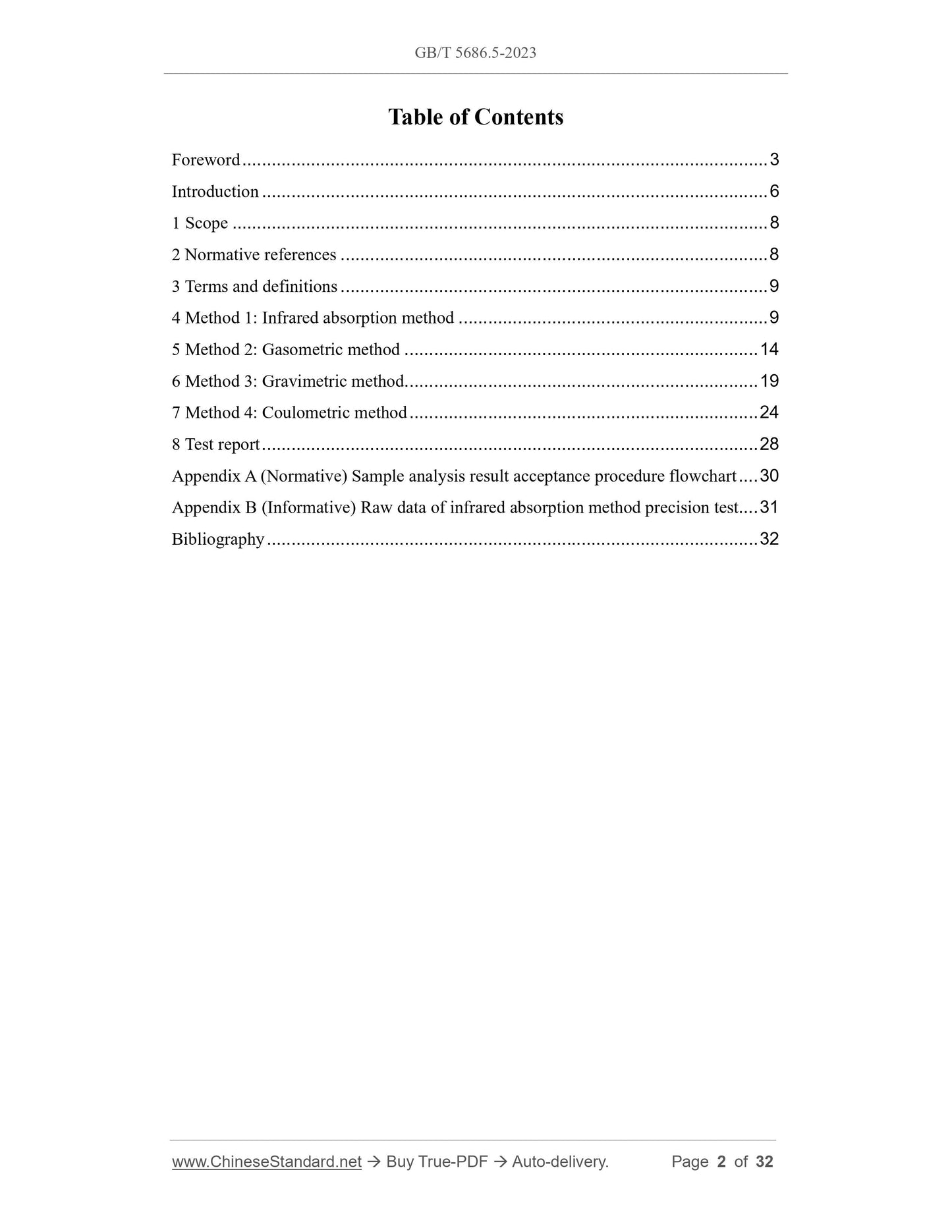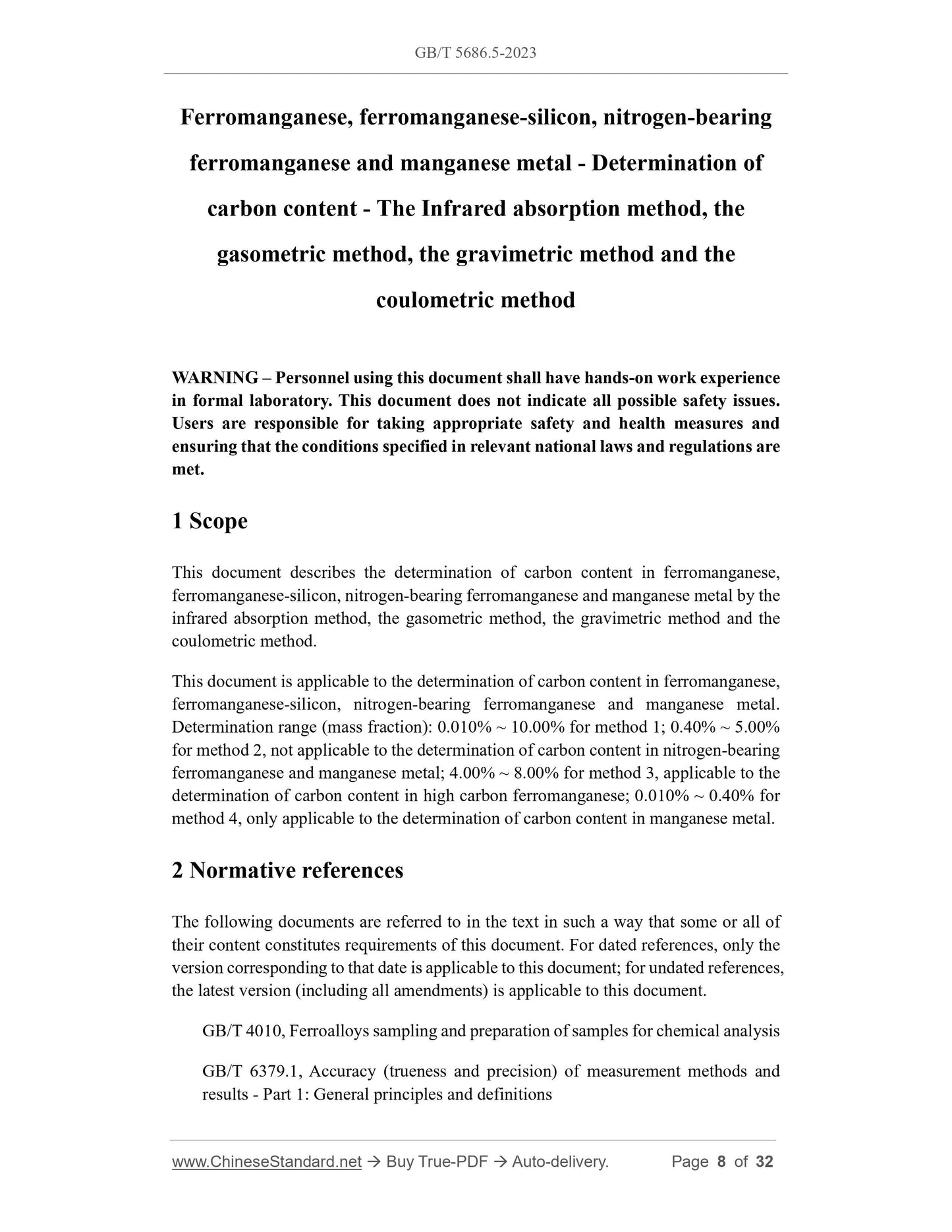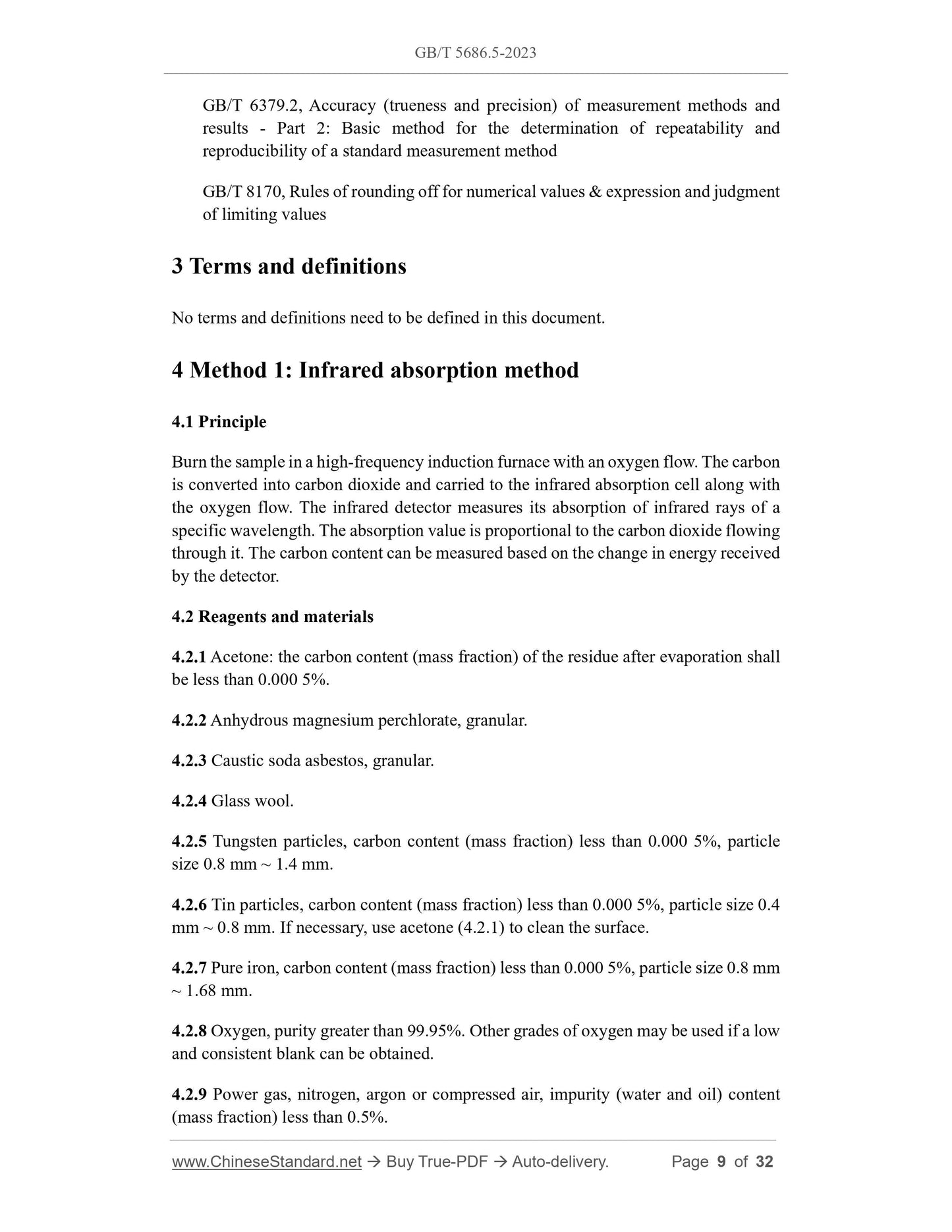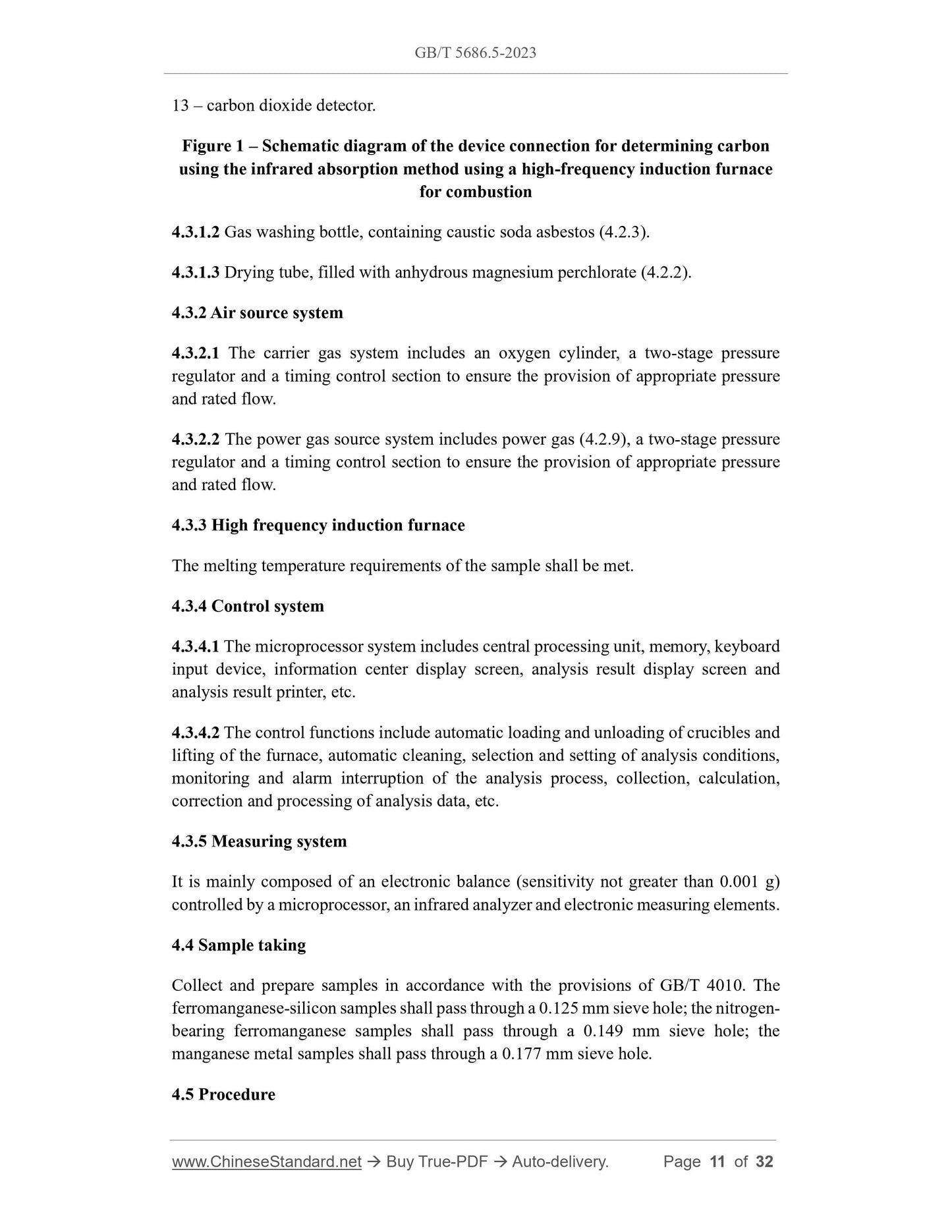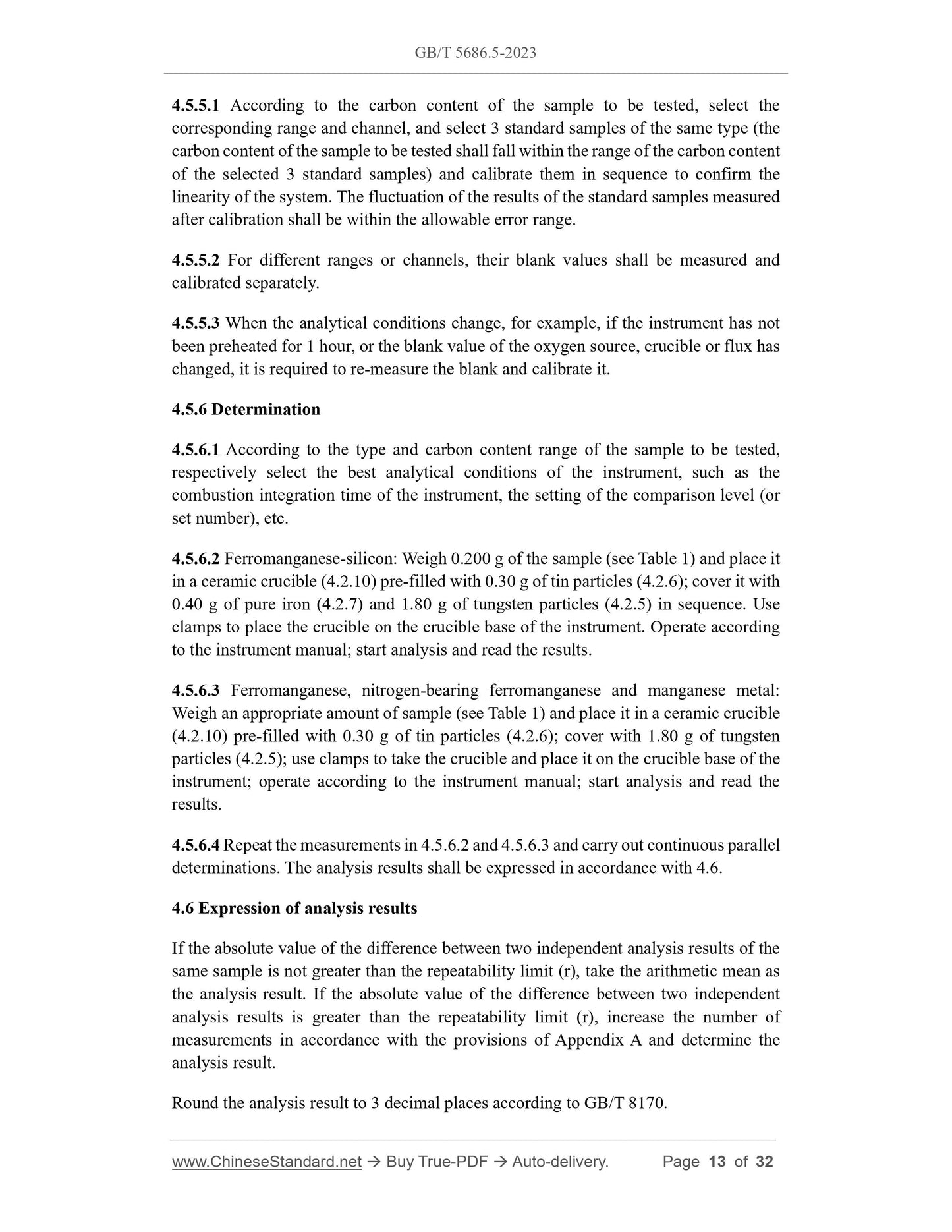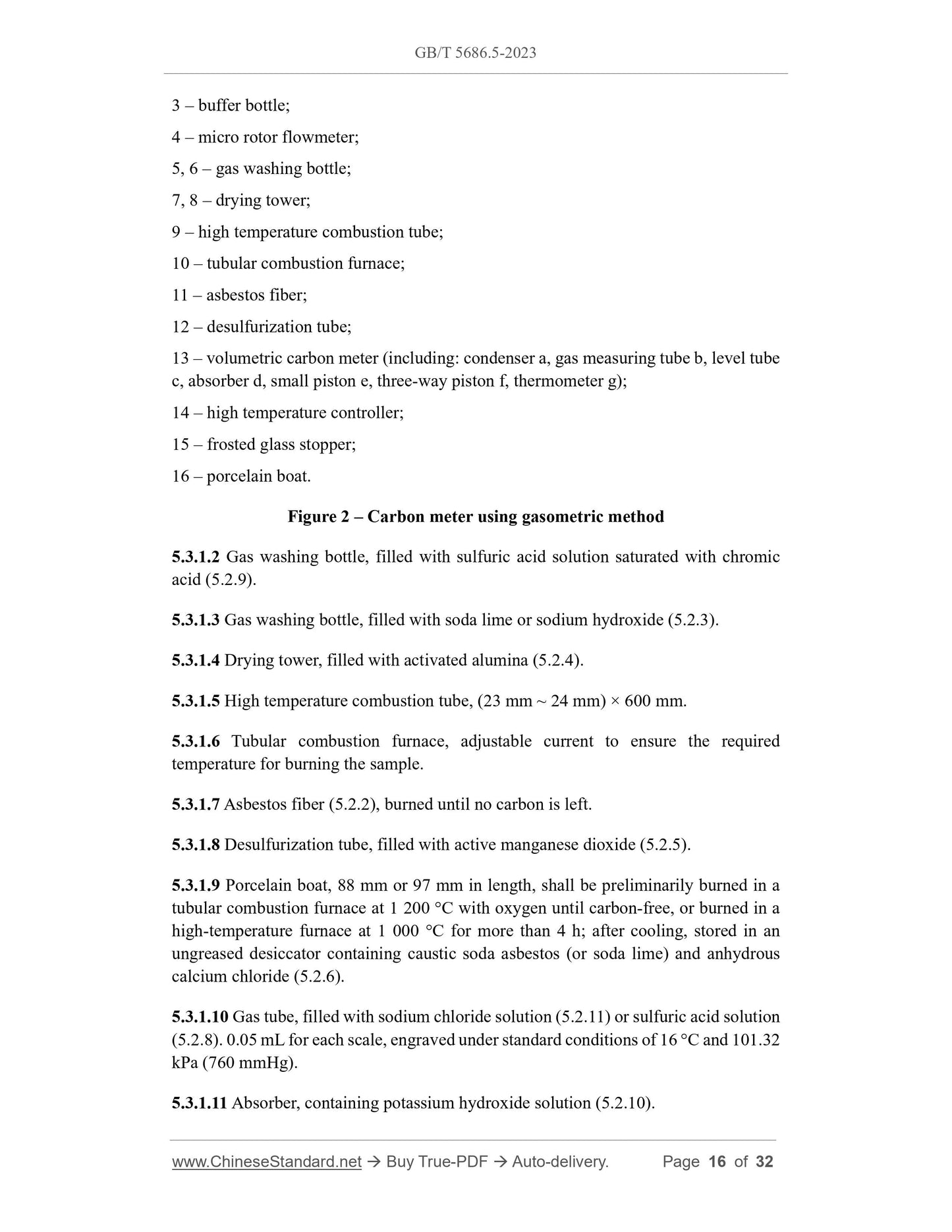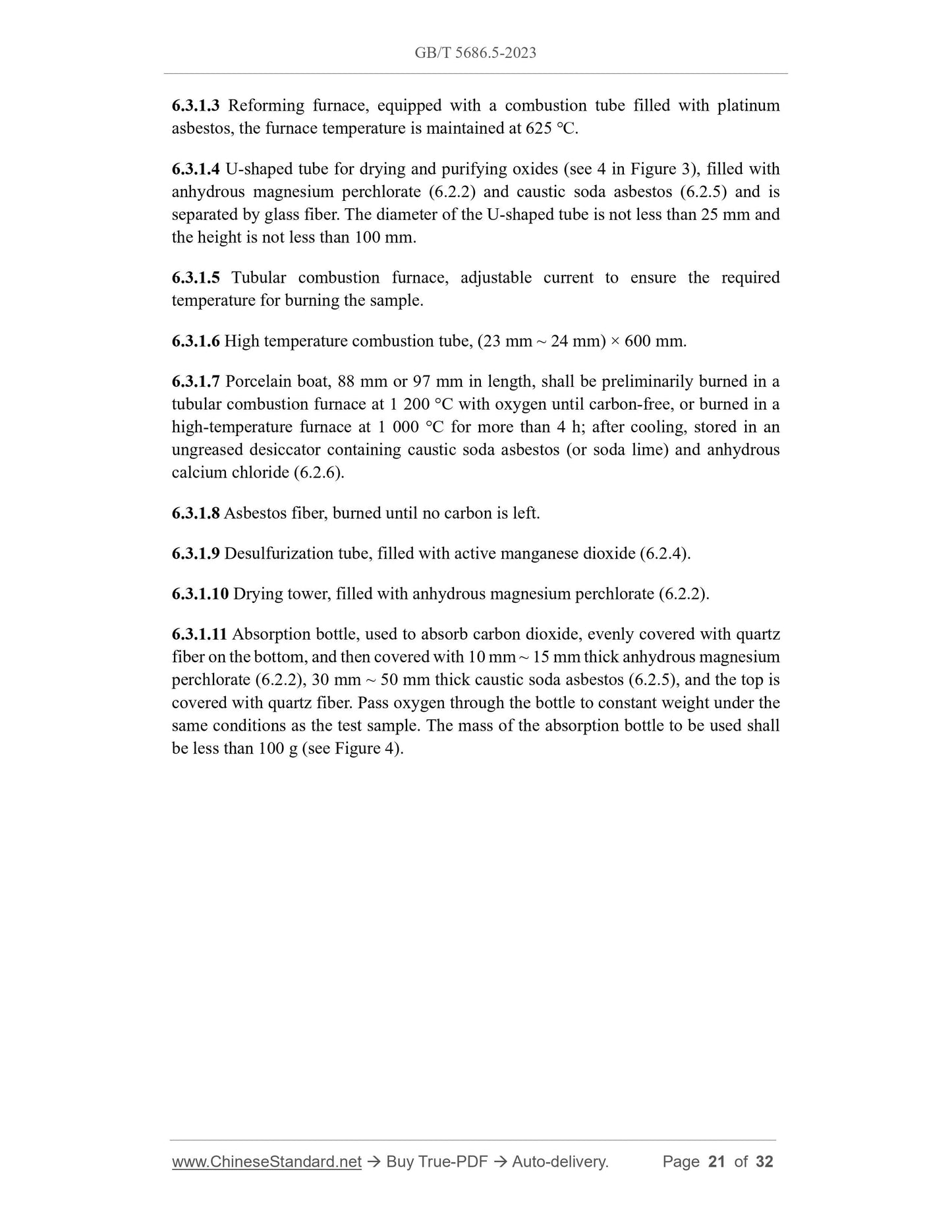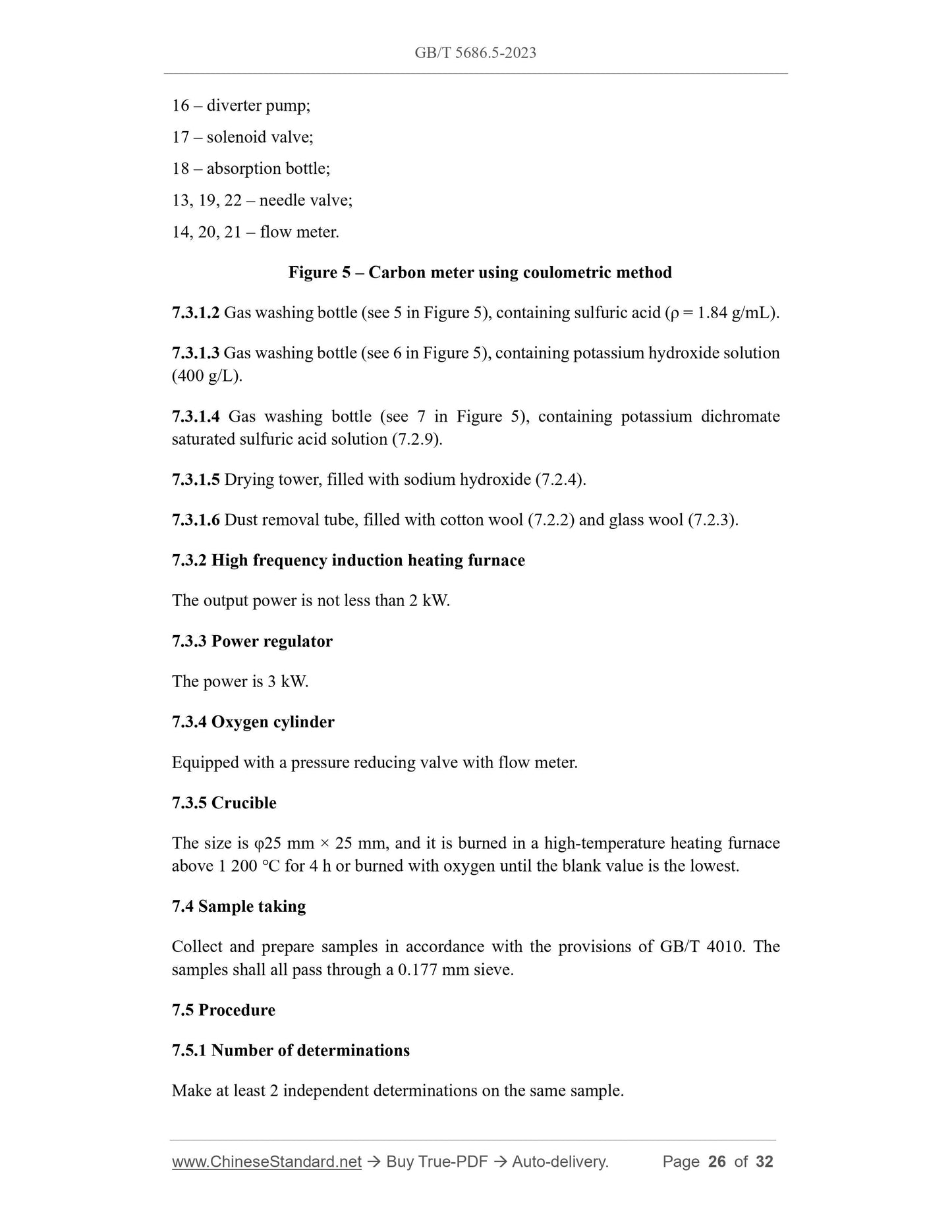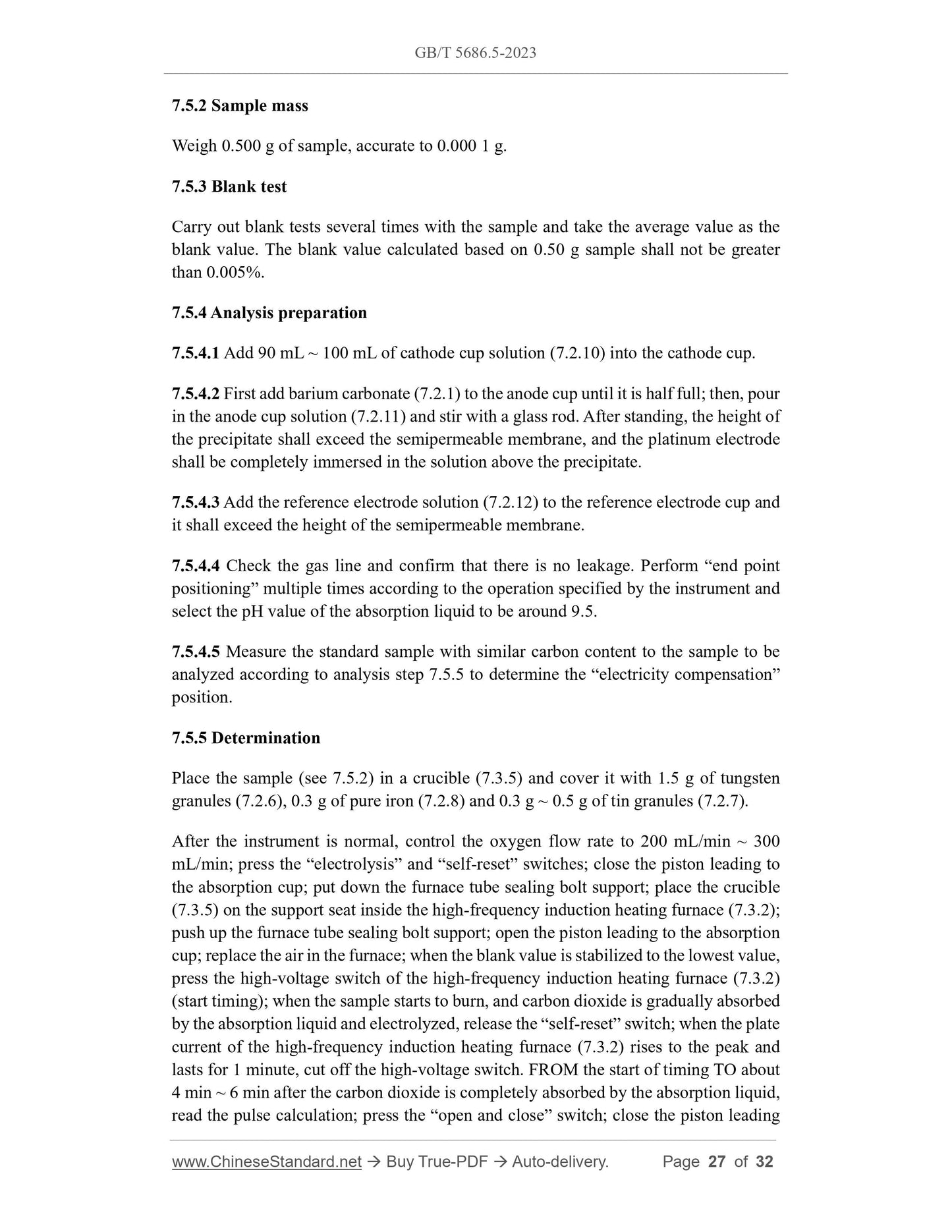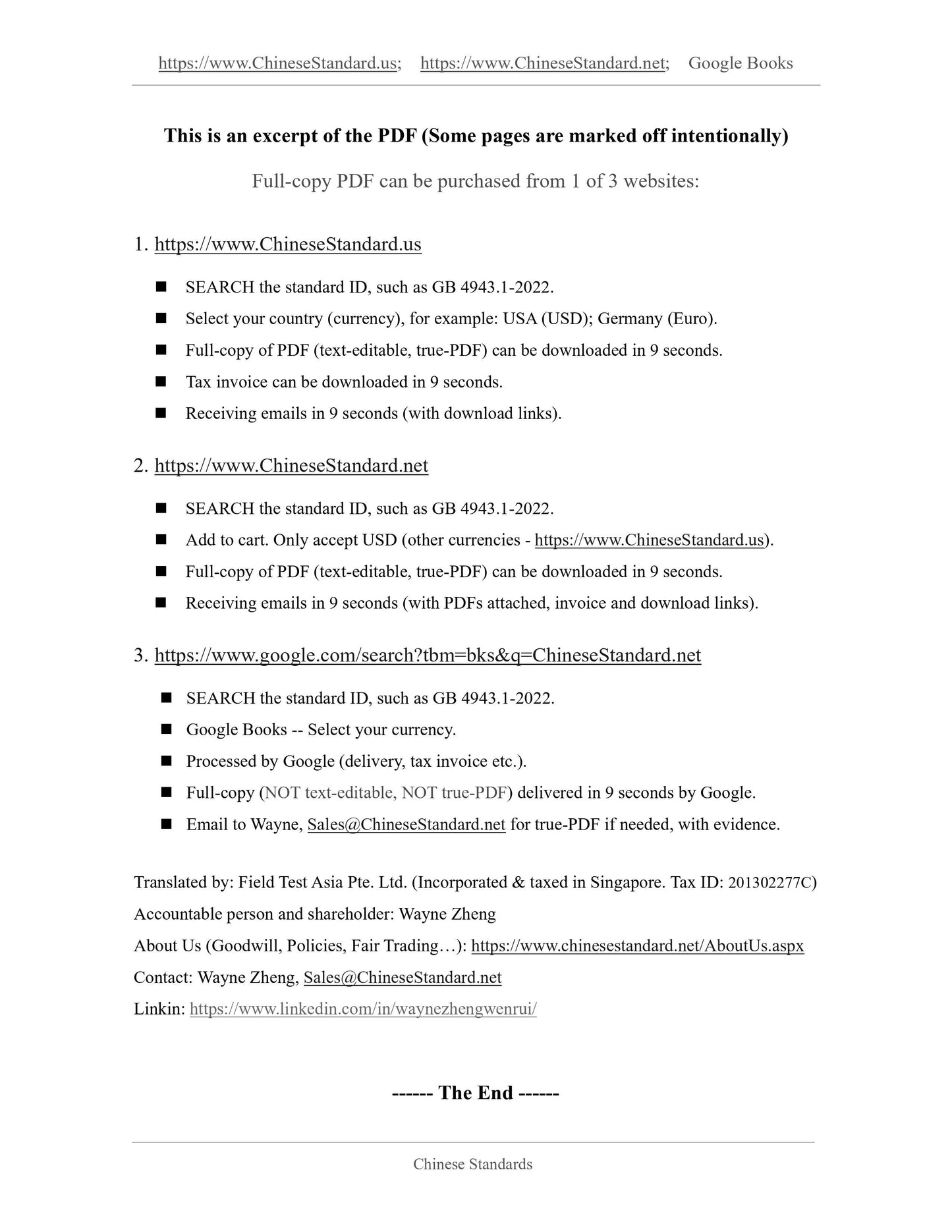1
/
of
11
www.ChineseStandard.us -- Field Test Asia Pte. Ltd.
GB/T 5686.5-2023 English PDF (GB/T5686.5-2023)
GB/T 5686.5-2023 English PDF (GB/T5686.5-2023)
Regular price
$380.00
Regular price
Sale price
$380.00
Unit price
/
per
Shipping calculated at checkout.
Couldn't load pickup availability
GB/T 5686.5-2023: Ferromanganese, ferromanganese-silicon, nitrogen-bearing ferromanganese and manganese metal - Determination of carbon content - The Infrared absorption method, the gasometric method, the gravimetric method and the coulometric method
Delivery: 9 seconds. Download (& Email) true-PDF + Invoice.
Get Quotation: Click GB/T 5686.5-2023 (Self-service in 1-minute)
Historical versions (Master-website): GB/T 5686.5-2023
Preview True-PDF (Reload/Scroll-down if blank)
GB/T 5686.5-2023
GB
NATIONAL STANDARD OF THE
PEOPLE’S REPUBLIC OF CHINA
ICS 77.100
CCS H 11
Replacing GB/T 5686.5-2008
Ferromanganese, ferromanganese-silicon, nitrogen-bearing
ferromanganese and manganese metal - Determination of
carbon content - The Infrared absorption method, the
gasometric method, the gravimetric method and the coulometric
method
ISSUED ON: NOVEMBER 27, 2023
IMPLEMENTED ON: JUNE 01, 2024
Issued by: State Administration for Market Regulation;
Standardization Administration of the People’s Republic of China.
Table of Contents
Foreword ... 3
Introduction ... 6
1 Scope ... 8
2 Normative references ... 8
3 Terms and definitions ... 9
4 Method 1: Infrared absorption method ... 9
5 Method 2: Gasometric method ... 14
6 Method 3: Gravimetric method ... 19
7 Method 4: Coulometric method ... 24
8 Test report ... 28
Appendix A (Normative) Sample analysis result acceptance procedure flowchart ... 30
Appendix B (Informative) Raw data of infrared absorption method precision test ... 31
Bibliography ... 32
Ferromanganese, ferromanganese-silicon, nitrogen-bearing
ferromanganese and manganese metal - Determination of
carbon content - The Infrared absorption method, the
gasometric method, the gravimetric method and the
coulometric method
WARNING – Personnel using this document shall have hands-on work experience
in formal laboratory. This document does not indicate all possible safety issues.
Users are responsible for taking appropriate safety and health measures and
ensuring that the conditions specified in relevant national laws and regulations are
met.
1 Scope
This document describes the determination of carbon content in ferromanganese,
ferromanganese-silicon, nitrogen-bearing ferromanganese and manganese metal by the
infrared absorption method, the gasometric method, the gravimetric method and the
coulometric method.
This document is applicable to the determination of carbon content in ferromanganese,
ferromanganese-silicon, nitrogen-bearing ferromanganese and manganese metal.
Determination range (mass fraction): 0.010% ~ 10.00% for method 1; 0.40% ~ 5.00%
for method 2, not applicable to the determination of carbon content in nitrogen-bearing
ferromanganese and manganese metal; 4.00% ~ 8.00% for method 3, applicable to the
determination of carbon content in high carbon ferromanganese; 0.010% ~ 0.40% for
method 4, only applicable to the determination of carbon content in manganese metal.
2 Normative references
The following documents are referred to in the text in such a way that some or all of
their content constitutes requirements of this document. For dated references, only the
version corresponding to that date is applicable to this document; for undated references,
the latest version (including all amendments) is applicable to this document.
GB/T 4010, Ferroalloys sampling and preparation of samples for chemical analysis
GB/T 6379.1, Accuracy (trueness and precision) of measurement methods and
results - Part 1: General principles and definitions
GB/T 6379.2, Accuracy (trueness and precision) of measurement methods and
results - Part 2: Basic method for the determination of repeatability and
reproducibility of a standard measurement method
GB/T 8170, Rules of rounding off for numerical values and expression and judgment
of limiting values
3 Terms and definitions
No terms and definitions need to be defined in this document.
4 Method 1: Infrared absorption method
4.1 Principle
Burn the sample in a high-frequency induction furnace with an oxygen flow. The carbon
is converted into carbon dioxide and carried to the infrared absorption cell along with
the oxygen flow. The infrared detector measures its absorption of infrared rays of a
specific wavelength. The absorption value is proportional to the carbon dioxide flowing
through it. The carbon content can be measured based on the change in energy received
by the detector.
4.2 Reagents and materials
4.2.1 Acetone: the carbon content (mass fraction) of the residue after evaporation shall
be less than 0.000 5%.
4.2.2 Anhydrous magnesium perchlorate, granular.
4.2.3 Caustic soda asbestos, granular.
4.2.4 Glass wool.
4.2.5 Tungsten particles, carbon content (mass fraction) less than 0.000 5%, particle
size 0.8 mm ~ 1.4 mm.
4.2.6 Tin particles, carbon content (mass fraction) less than 0.000 5%, particle size 0.4
mm ~ 0.8 mm. If necessary, use acetone (4.2.1) to clean the surface.
4.2.7 Pure iron, carbon content (mass fraction) less than 0.000 5%, particle size 0.8 mm
~ 1.68 mm.
4.2.8 Oxygen, purity greater than 99.95%. Other grades of oxygen may be used if a low
and consistent blank can be obtained.
4.2.9 Power gas, nitrogen, argon or compressed air, impurity (water and oil) content
(mass fraction) less than 0.5%.
13 – carbon dioxide detector.
Figure 1 – Schematic diagram of the device connection for determining carbon
using the infrared absorption method using a high-frequency induction furnace
for combustion
4.3.1.2 Gas washing bottle, containing caustic soda asbestos (4.2.3).
4.3.1.3 Drying tube, filled with anhydrous magnesium perchlorate (4.2.2).
4.3.2 Air source system
4.3.2.1 The carrier gas system includes an oxygen cylinder, a two-stage pressure
regulator and a timing control section to ensure the provision of appropriate pressure
and rated flow.
4.3.2.2 The power gas source system includes power gas (4.2.9), a two-stage pressure
regulator and a timing control section to ensure the provision of appropriate pressure
and rated flow.
4.3.3 High frequency induction furnace
The melting temperature requirements of the sample shall be met.
4.3.4 Control system
4.3.4.1 The microprocessor system includes central processing unit, memory, keyboard
input device, information center display screen, analysis result display screen and
analysis result printer, etc.
4.3.4.2 The control functions include automatic loading and unloading of crucibles and
lifting of the furnace, automatic cleaning, selection and setting of analysis conditions,
monitoring and alarm interruption of the analysis process, collection, calculation,
correction and processing of analysis data, etc.
4.3.5 Measuring system
It is mainly composed of an electronic balance (sensitivity not greater than 0.001 g)
controlled by a microprocessor, an infrared analyzer and electronic measuring elements.
4.4 Sample taking
Collect and prepare samples in accordance with the provisions of GB/T 4010. The
ferromanganese-silicon samples shall pass through a 0.125 mm sieve hole; the nitrogen-
bearing ferromanganese samples shall pass through a 0.149 mm sieve hole; the
manganese metal samples shall pass through a 0.177 mm sieve hole.
4.5 Procedure
4.5.5.1 According to the carbon content of the sample to be tested, select the
corresponding range and channel, and select 3 standard samples of the same type (the
carbon content of the sample to be tested shall fall within the range of the carbon content
of the selected 3 standard samples) and calibrate them in sequence to confirm the
linearity of the system. The fluctuation of the results of the standard samples measured
after calibration shall be within the allowable error range.
4.5.5.2 For different ranges or channels, their blank values shall be measured and
calibrated separately.
4.5.5.3 When the analytical conditions change, for example, if the instrument has not
been preheated for 1 hour, or the blank value of the oxygen source, crucible or flux has
changed, it is required to re-measure the blank and calibrate it.
4.5.6 Determination
4.5.6.1 According to the type and carbon content range of the sample to be tested,
respectively select the best analytical conditions of the instrument, such as the
combustion integration time of the instrument, the setting of the comparison level (or
set number), etc.
4.5.6.2 Ferromanganese-silicon: Weigh 0.200 g of the sample (see Table 1) and place it
in a ceramic crucible (4.2.10) pre-filled with 0.30 g of tin particles (4.2.6); cover it with
0.40 g of pure iron (4.2.7) and 1.80 g of tungsten particles (4.2.5) in sequence. Use
clamps to place the crucible on the crucible base of the instrument. Operate according
to the instrument manual; start analysis and read the results.
4.5.6.3 Ferromanganese, nitrogen-bearing ferromanganese and manganese metal:
Weigh an appropriate amount of sample (see Table 1) and place it in a ceramic crucible
(4.2.10) pre-filled with 0.30 g of tin particles (4.2.6); cover with 1.80 g of tungsten
particles (4.2.5); use clamps to take the crucible and place it on the crucible base of the
instrument; operate according to the instrument manual; start analysis and read the
results.
4.5.6.4 Repeat the measurements in 4.5.6.2 and 4.5.6.3 and carry out continuous parallel
determinations. The analysis results shall be expressed in accordance with 4.6.
4.6 Expression of analysis results
If the absolute value of the difference between two independent analysis results of the
same sample is not greater than the repeatability limit (r), take the arithmetic mean as
the analysis result. If the absolute value of the difference between two independent
analysis results is greater than the repeatability limit (r), increase the number of
measurements in accordance with the provisions of Appendix A and determine the
analysis result.
Round the analysis result to 3 decimal places according to GB/T 8170.
3 – buffer bottle;
4 – micro rotor flowmeter;
5, 6 – gas washing bottle;
7, 8 – drying tower;
9 – high temperature combustion tube;
10 – tubular combustion furnace;
11 – asbestos fiber;
12 – desulfurization tube;
13 – volumetric carbon meter (including: condenser a, gas measuring tube b, level tube
c, absorber d, small piston e, three-way piston f, thermometer g);
14 – high temperature controller;
15 – frosted glass stopper;
16 – porcelain boat.
Figure 2 – Carbon meter using gasometric method
5.3.1.2 Gas washing bottle, filled with sulfuric acid solution saturated with chromic
acid (5.2.9).
5.3.1.3 Gas washing bottle, filled with soda lime or sodium hydroxide (5.2.3).
5.3.1.4 Drying tower, filled with activated alumina (5.2.4).
5.3.1.5 High temperature combustion tube, (23 mm ~ 24 mm) × 600 mm.
5.3.1.6 Tubular combustion furnace, adjustable current to ensure the required
temperature for burning the sample.
5.3.1.7 Asbestos fiber (5.2.2), burned until no carbon is left.
5.3.1.8 Desulfurization tube, filled with active manganese dioxide (5.2.5).
5.3.1.9 Porcelain boat, 88 mm or 97 mm in length, shall be preliminarily burned in a
tubular combustion furnace at 1 200 °C with oxygen until carbon-free, or burned in a
high-temperature furnace at 1 000 °C for more than 4 h; after cooling, stored in an
ungreased desiccator containing caustic soda asbestos (or soda lime) and anhydrous
calcium chloride (5.2.6).
5.3.1.10 Gas tube, filled with sodium chloride solution (5.2.11) or sulfuric acid solution
(5.2.8). 0.05 mL for each scale, engraved under standard conditions of 16 °C and 101.32
kPa (760 mmHg).
5.3.1.11 Absorber, containing potassium hydroxide solution (5.2.10).
6.3.1.3 Reforming furnace, equipped with a combustion tube filled with platinum
asbestos, the furnace temperature is maintained at 625 ℃.
6.3.1.4 U-shaped tube for drying and purifying oxides (see 4 in Figure 3), filled with
anhydrous magnesium perchlorate (6.2.2) and caustic soda asbestos (6.2.5) and is
separated by glass fiber. The diameter of the U-shaped tube is not less than 25 mm and
the height is not less than 100 mm.
6.3.1.5 Tubular combustion furnace, adjustable current to ensure the required
temperature for burning the sample.
6.3.1.6 High temperature combustion tube, (23 mm ~ 24 mm) × 600 mm.
6.3.1.7 Porcelain boat, 88 mm or 97 mm in length, shall be preliminarily burned in a
tubular combustion furnace at 1 200 °C with oxygen until carbon-free, or burned in a
high-temperature furnace at 1 000 °C for more than 4 h; after cooling, stored in an
ungreased desiccator containing caustic soda asbestos (or soda lime) and anhydrous
calcium chloride (6.2.6).
6.3.1.8 Asbestos fiber, burned until no carbon is left.
6.3.1.9 Desulfurization tube, filled with active manganese dioxide (6.2.4).
6.3.1.10 Drying tower, filled with anhydrous magnesium perchlorate (6.2.2).
6.3.1.11 Absorption bottle, used to absorb carbon dioxide, evenly covered with quartz
fiber on the bottom, and then covered with 10 mm ~ 15 mm thick anhydrous magnesium
perchlorate (6.2.2), 30 mm ~ 50 mm thick caustic soda asbestos (6.2.5), and the top is
covered with quartz fiber. Pass oxygen through the bottle to constant weight under the
same conditions as the test sample. The mass of the absorption bottle to be used shall
be less than 100 g (see Figure 4).
16 – diverter pump;
17 – solenoid valve;
18 – absorption bottle;
13, 19, 22 – needle valve;
14, 20, 21 – flow meter.
Figure 5 – Carbon meter using coulometric method
7.3.1.2 Gas washing bottle (see 5 in Figure 5), containing sulfuric acid (ρ = 1.84 g/mL).
7.3.1.3 Gas washing bottle (see 6 in Figure 5), containing potassium hydroxide solution
(400 g/L).
7.3.1.4 Gas washing bottle (see 7 in Figure 5), containing potassium dichromate
saturated sulfuric acid solution (7.2.9).
7.3.1.5 Drying tower, filled with sodium hydroxide (7.2.4).
7.3.1.6 Dust removal tube, filled with cotton wool (7.2.2) and glass wool (7.2.3).
7.3.2 High frequency induction heating furnace
The output power is not less than 2 kW.
7.3.3 Power regulator
The power is 3 kW.
7.3.4 Oxygen cylinder
Equipped with a pressure reducing valve with flow meter.
7.3.5 Crucible
The size is φ25 mm × 25 mm, and it is burned in a high-temperature heating furnace
above 1 200 ℃ for 4 h or burned with oxygen until the blank value is the lowest.
7.4 Sample taking
Collect and prepare samples in accordance with the provisions of GB/T 4010. The
samples sh...
Delivery: 9 seconds. Download (& Email) true-PDF + Invoice.
Get Quotation: Click GB/T 5686.5-2023 (Self-service in 1-minute)
Historical versions (Master-website): GB/T 5686.5-2023
Preview True-PDF (Reload/Scroll-down if blank)
GB/T 5686.5-2023
GB
NATIONAL STANDARD OF THE
PEOPLE’S REPUBLIC OF CHINA
ICS 77.100
CCS H 11
Replacing GB/T 5686.5-2008
Ferromanganese, ferromanganese-silicon, nitrogen-bearing
ferromanganese and manganese metal - Determination of
carbon content - The Infrared absorption method, the
gasometric method, the gravimetric method and the coulometric
method
ISSUED ON: NOVEMBER 27, 2023
IMPLEMENTED ON: JUNE 01, 2024
Issued by: State Administration for Market Regulation;
Standardization Administration of the People’s Republic of China.
Table of Contents
Foreword ... 3
Introduction ... 6
1 Scope ... 8
2 Normative references ... 8
3 Terms and definitions ... 9
4 Method 1: Infrared absorption method ... 9
5 Method 2: Gasometric method ... 14
6 Method 3: Gravimetric method ... 19
7 Method 4: Coulometric method ... 24
8 Test report ... 28
Appendix A (Normative) Sample analysis result acceptance procedure flowchart ... 30
Appendix B (Informative) Raw data of infrared absorption method precision test ... 31
Bibliography ... 32
Ferromanganese, ferromanganese-silicon, nitrogen-bearing
ferromanganese and manganese metal - Determination of
carbon content - The Infrared absorption method, the
gasometric method, the gravimetric method and the
coulometric method
WARNING – Personnel using this document shall have hands-on work experience
in formal laboratory. This document does not indicate all possible safety issues.
Users are responsible for taking appropriate safety and health measures and
ensuring that the conditions specified in relevant national laws and regulations are
met.
1 Scope
This document describes the determination of carbon content in ferromanganese,
ferromanganese-silicon, nitrogen-bearing ferromanganese and manganese metal by the
infrared absorption method, the gasometric method, the gravimetric method and the
coulometric method.
This document is applicable to the determination of carbon content in ferromanganese,
ferromanganese-silicon, nitrogen-bearing ferromanganese and manganese metal.
Determination range (mass fraction): 0.010% ~ 10.00% for method 1; 0.40% ~ 5.00%
for method 2, not applicable to the determination of carbon content in nitrogen-bearing
ferromanganese and manganese metal; 4.00% ~ 8.00% for method 3, applicable to the
determination of carbon content in high carbon ferromanganese; 0.010% ~ 0.40% for
method 4, only applicable to the determination of carbon content in manganese metal.
2 Normative references
The following documents are referred to in the text in such a way that some or all of
their content constitutes requirements of this document. For dated references, only the
version corresponding to that date is applicable to this document; for undated references,
the latest version (including all amendments) is applicable to this document.
GB/T 4010, Ferroalloys sampling and preparation of samples for chemical analysis
GB/T 6379.1, Accuracy (trueness and precision) of measurement methods and
results - Part 1: General principles and definitions
GB/T 6379.2, Accuracy (trueness and precision) of measurement methods and
results - Part 2: Basic method for the determination of repeatability and
reproducibility of a standard measurement method
GB/T 8170, Rules of rounding off for numerical values and expression and judgment
of limiting values
3 Terms and definitions
No terms and definitions need to be defined in this document.
4 Method 1: Infrared absorption method
4.1 Principle
Burn the sample in a high-frequency induction furnace with an oxygen flow. The carbon
is converted into carbon dioxide and carried to the infrared absorption cell along with
the oxygen flow. The infrared detector measures its absorption of infrared rays of a
specific wavelength. The absorption value is proportional to the carbon dioxide flowing
through it. The carbon content can be measured based on the change in energy received
by the detector.
4.2 Reagents and materials
4.2.1 Acetone: the carbon content (mass fraction) of the residue after evaporation shall
be less than 0.000 5%.
4.2.2 Anhydrous magnesium perchlorate, granular.
4.2.3 Caustic soda asbestos, granular.
4.2.4 Glass wool.
4.2.5 Tungsten particles, carbon content (mass fraction) less than 0.000 5%, particle
size 0.8 mm ~ 1.4 mm.
4.2.6 Tin particles, carbon content (mass fraction) less than 0.000 5%, particle size 0.4
mm ~ 0.8 mm. If necessary, use acetone (4.2.1) to clean the surface.
4.2.7 Pure iron, carbon content (mass fraction) less than 0.000 5%, particle size 0.8 mm
~ 1.68 mm.
4.2.8 Oxygen, purity greater than 99.95%. Other grades of oxygen may be used if a low
and consistent blank can be obtained.
4.2.9 Power gas, nitrogen, argon or compressed air, impurity (water and oil) content
(mass fraction) less than 0.5%.
13 – carbon dioxide detector.
Figure 1 – Schematic diagram of the device connection for determining carbon
using the infrared absorption method using a high-frequency induction furnace
for combustion
4.3.1.2 Gas washing bottle, containing caustic soda asbestos (4.2.3).
4.3.1.3 Drying tube, filled with anhydrous magnesium perchlorate (4.2.2).
4.3.2 Air source system
4.3.2.1 The carrier gas system includes an oxygen cylinder, a two-stage pressure
regulator and a timing control section to ensure the provision of appropriate pressure
and rated flow.
4.3.2.2 The power gas source system includes power gas (4.2.9), a two-stage pressure
regulator and a timing control section to ensure the provision of appropriate pressure
and rated flow.
4.3.3 High frequency induction furnace
The melting temperature requirements of the sample shall be met.
4.3.4 Control system
4.3.4.1 The microprocessor system includes central processing unit, memory, keyboard
input device, information center display screen, analysis result display screen and
analysis result printer, etc.
4.3.4.2 The control functions include automatic loading and unloading of crucibles and
lifting of the furnace, automatic cleaning, selection and setting of analysis conditions,
monitoring and alarm interruption of the analysis process, collection, calculation,
correction and processing of analysis data, etc.
4.3.5 Measuring system
It is mainly composed of an electronic balance (sensitivity not greater than 0.001 g)
controlled by a microprocessor, an infrared analyzer and electronic measuring elements.
4.4 Sample taking
Collect and prepare samples in accordance with the provisions of GB/T 4010. The
ferromanganese-silicon samples shall pass through a 0.125 mm sieve hole; the nitrogen-
bearing ferromanganese samples shall pass through a 0.149 mm sieve hole; the
manganese metal samples shall pass through a 0.177 mm sieve hole.
4.5 Procedure
4.5.5.1 According to the carbon content of the sample to be tested, select the
corresponding range and channel, and select 3 standard samples of the same type (the
carbon content of the sample to be tested shall fall within the range of the carbon content
of the selected 3 standard samples) and calibrate them in sequence to confirm the
linearity of the system. The fluctuation of the results of the standard samples measured
after calibration shall be within the allowable error range.
4.5.5.2 For different ranges or channels, their blank values shall be measured and
calibrated separately.
4.5.5.3 When the analytical conditions change, for example, if the instrument has not
been preheated for 1 hour, or the blank value of the oxygen source, crucible or flux has
changed, it is required to re-measure the blank and calibrate it.
4.5.6 Determination
4.5.6.1 According to the type and carbon content range of the sample to be tested,
respectively select the best analytical conditions of the instrument, such as the
combustion integration time of the instrument, the setting of the comparison level (or
set number), etc.
4.5.6.2 Ferromanganese-silicon: Weigh 0.200 g of the sample (see Table 1) and place it
in a ceramic crucible (4.2.10) pre-filled with 0.30 g of tin particles (4.2.6); cover it with
0.40 g of pure iron (4.2.7) and 1.80 g of tungsten particles (4.2.5) in sequence. Use
clamps to place the crucible on the crucible base of the instrument. Operate according
to the instrument manual; start analysis and read the results.
4.5.6.3 Ferromanganese, nitrogen-bearing ferromanganese and manganese metal:
Weigh an appropriate amount of sample (see Table 1) and place it in a ceramic crucible
(4.2.10) pre-filled with 0.30 g of tin particles (4.2.6); cover with 1.80 g of tungsten
particles (4.2.5); use clamps to take the crucible and place it on the crucible base of the
instrument; operate according to the instrument manual; start analysis and read the
results.
4.5.6.4 Repeat the measurements in 4.5.6.2 and 4.5.6.3 and carry out continuous parallel
determinations. The analysis results shall be expressed in accordance with 4.6.
4.6 Expression of analysis results
If the absolute value of the difference between two independent analysis results of the
same sample is not greater than the repeatability limit (r), take the arithmetic mean as
the analysis result. If the absolute value of the difference between two independent
analysis results is greater than the repeatability limit (r), increase the number of
measurements in accordance with the provisions of Appendix A and determine the
analysis result.
Round the analysis result to 3 decimal places according to GB/T 8170.
3 – buffer bottle;
4 – micro rotor flowmeter;
5, 6 – gas washing bottle;
7, 8 – drying tower;
9 – high temperature combustion tube;
10 – tubular combustion furnace;
11 – asbestos fiber;
12 – desulfurization tube;
13 – volumetric carbon meter (including: condenser a, gas measuring tube b, level tube
c, absorber d, small piston e, three-way piston f, thermometer g);
14 – high temperature controller;
15 – frosted glass stopper;
16 – porcelain boat.
Figure 2 – Carbon meter using gasometric method
5.3.1.2 Gas washing bottle, filled with sulfuric acid solution saturated with chromic
acid (5.2.9).
5.3.1.3 Gas washing bottle, filled with soda lime or sodium hydroxide (5.2.3).
5.3.1.4 Drying tower, filled with activated alumina (5.2.4).
5.3.1.5 High temperature combustion tube, (23 mm ~ 24 mm) × 600 mm.
5.3.1.6 Tubular combustion furnace, adjustable current to ensure the required
temperature for burning the sample.
5.3.1.7 Asbestos fiber (5.2.2), burned until no carbon is left.
5.3.1.8 Desulfurization tube, filled with active manganese dioxide (5.2.5).
5.3.1.9 Porcelain boat, 88 mm or 97 mm in length, shall be preliminarily burned in a
tubular combustion furnace at 1 200 °C with oxygen until carbon-free, or burned in a
high-temperature furnace at 1 000 °C for more than 4 h; after cooling, stored in an
ungreased desiccator containing caustic soda asbestos (or soda lime) and anhydrous
calcium chloride (5.2.6).
5.3.1.10 Gas tube, filled with sodium chloride solution (5.2.11) or sulfuric acid solution
(5.2.8). 0.05 mL for each scale, engraved under standard conditions of 16 °C and 101.32
kPa (760 mmHg).
5.3.1.11 Absorber, containing potassium hydroxide solution (5.2.10).
6.3.1.3 Reforming furnace, equipped with a combustion tube filled with platinum
asbestos, the furnace temperature is maintained at 625 ℃.
6.3.1.4 U-shaped tube for drying and purifying oxides (see 4 in Figure 3), filled with
anhydrous magnesium perchlorate (6.2.2) and caustic soda asbestos (6.2.5) and is
separated by glass fiber. The diameter of the U-shaped tube is not less than 25 mm and
the height is not less than 100 mm.
6.3.1.5 Tubular combustion furnace, adjustable current to ensure the required
temperature for burning the sample.
6.3.1.6 High temperature combustion tube, (23 mm ~ 24 mm) × 600 mm.
6.3.1.7 Porcelain boat, 88 mm or 97 mm in length, shall be preliminarily burned in a
tubular combustion furnace at 1 200 °C with oxygen until carbon-free, or burned in a
high-temperature furnace at 1 000 °C for more than 4 h; after cooling, stored in an
ungreased desiccator containing caustic soda asbestos (or soda lime) and anhydrous
calcium chloride (6.2.6).
6.3.1.8 Asbestos fiber, burned until no carbon is left.
6.3.1.9 Desulfurization tube, filled with active manganese dioxide (6.2.4).
6.3.1.10 Drying tower, filled with anhydrous magnesium perchlorate (6.2.2).
6.3.1.11 Absorption bottle, used to absorb carbon dioxide, evenly covered with quartz
fiber on the bottom, and then covered with 10 mm ~ 15 mm thick anhydrous magnesium
perchlorate (6.2.2), 30 mm ~ 50 mm thick caustic soda asbestos (6.2.5), and the top is
covered with quartz fiber. Pass oxygen through the bottle to constant weight under the
same conditions as the test sample. The mass of the absorption bottle to be used shall
be less than 100 g (see Figure 4).
16 – diverter pump;
17 – solenoid valve;
18 – absorption bottle;
13, 19, 22 – needle valve;
14, 20, 21 – flow meter.
Figure 5 – Carbon meter using coulometric method
7.3.1.2 Gas washing bottle (see 5 in Figure 5), containing sulfuric acid (ρ = 1.84 g/mL).
7.3.1.3 Gas washing bottle (see 6 in Figure 5), containing potassium hydroxide solution
(400 g/L).
7.3.1.4 Gas washing bottle (see 7 in Figure 5), containing potassium dichromate
saturated sulfuric acid solution (7.2.9).
7.3.1.5 Drying tower, filled with sodium hydroxide (7.2.4).
7.3.1.6 Dust removal tube, filled with cotton wool (7.2.2) and glass wool (7.2.3).
7.3.2 High frequency induction heating furnace
The output power is not less than 2 kW.
7.3.3 Power regulator
The power is 3 kW.
7.3.4 Oxygen cylinder
Equipped with a pressure reducing valve with flow meter.
7.3.5 Crucible
The size is φ25 mm × 25 mm, and it is burned in a high-temperature heating furnace
above 1 200 ℃ for 4 h or burned with oxygen until the blank value is the lowest.
7.4 Sample taking
Collect and prepare samples in accordance with the provisions of GB/T 4010. The
samples sh...
Share
